
Farmer is a town in Hanson County, South Dakota, United States. It is part of the Mitchell, South Dakota Micropolitan Statistical Area. The population was 15 at the 2020 census.

This is a list of sites in Minnesota which are included in the National Register of Historic Places. There are more than 1,700 properties and historic districts listed on the NRHP; each of Minnesota's 87 counties has at least 2 listings. Twenty-two sites are also National Historic Landmarks.

St. Croix State Park is a state park in Pine County, Minnesota, USA. The park follows the shore of the St. Croix River for 21 miles (34 km) and contains the last 7 miles (11 km) of the Kettle River. At 33,895 acres (13,717 ha) it is the largest Minnesota state park. It was developed as a Recreational Demonstration Area in the 1930s, and is one of the finest surviving properties of this type in the nation. 164 structures built by the Civilian Conservation Corps and the Works Progress Administration survive, the largest collection of New Deal projects in Minnesota. As a historic district they were listed on the National Register of Historic Places and proclaimed a National Historic Landmark in 1997.
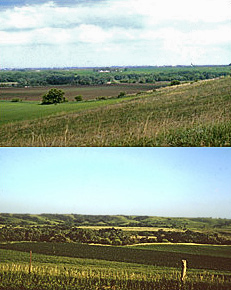
The Blood Run Site is an archaeological site on the border of the US states of Iowa and South Dakota. The site was essentially populated for 8,500 years, within which earthworks structures were built by the Oneota Culture and occupied by descendant tribes such as the Ioway, Otoe, Missouri, and shared with Quapaw and later Kansa, Osage, and Omaha people. The site was so named on account of the iron-stained soil.
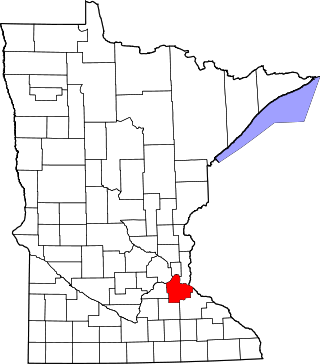
This is a list of the National Register of Historic Places listings in Dakota County, Minnesota. It is intended to be a complete list of the properties and districts on the National Register of Historic Places in Dakota County, Minnesota, United States. Dakota County is located in the southeastern part of the U.S. state of Minnesota, bounded on the northeast side by the Upper Mississippi River and on the northwest by the Minnesota River. The locations of National Register properties and districts for which the latitude and longitude coordinates are included below, may be seen in an online map.

This list is of the properties and historic districts which are designated on the National Register of Historic Places or that were formerly so designated, in Hennepin County, Minnesota; there are 190 entries as of April 2023. A significant number of these properties are a result of the establishment of Fort Snelling, the development of water power at Saint Anthony Falls, and the thriving city of Minneapolis that developed around the falls. Many historic sites outside the Minneapolis city limits are associated with pioneers who established missions, farms, and schools in areas that are now suburbs in that metropolitan area.

The Assumption of the Blessed Virgin Mary Church is a Catholic church of the Archdiocese of Detroit located at 13770 Gratiot Avenue in Detroit, Michigan. It is commonly known as the Assumption Grotto Church. The church community was founded in the 1830s, and the present building completed in 1929, designated a Michigan State Historic Site in 1990 and listed on the National Register of Historic Places in 1991.
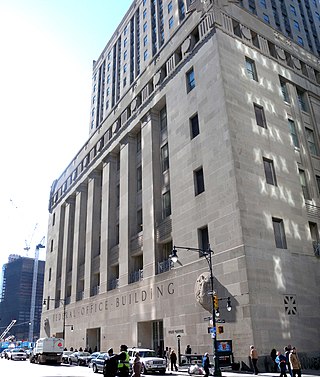
Church Street and Trinity Place form a single northbound roadway in Lower Manhattan, New York City. Its northern end is at Canal Street and its southern end is at Morris Street, where Trinity Place merges with Greenwich Street. The dividing point is Liberty Street.

This is a list of the National Register of Historic Places listings in Jones County, South Dakota.

The historical buildings and structures of Zion National Park represent a variety of buildings, interpretive structures, signs and infrastructure associated with the National Park Service's operations in Zion National Park, Utah. Structures vary in size and scale from the Zion Lodge to road culverts and curbs, nearly all of which were designed using native materials and regional construction techniques in an adapted version of the National Park Service Rustic style. A number of the larger structures were designed by Gilbert Stanley Underwood, while many of the smaller structures were designed or coordinated with the National Park Service Branch of Plans and Designs. The bulk of the historic structures date to the 1920s and 1930s. Most of the structures of the 1930s were built using Civilian Conservation Corps labor.
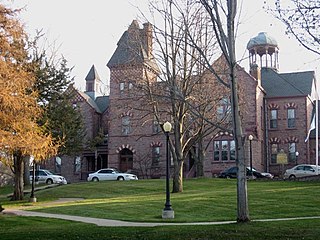
The All Saints School is a historic private school in Sioux Falls, South Dakota. William Hobart Hare, the first Episcopal bishop of South Dakota, founded the school to serve as a girls' boarding school for the children of Episcopal missionaries. The school's main building, a four-story granite Prairie Gothic structure with a distinctive bell tower, was built in 1884. A cupola sits atop the building's front entrance; Hare's personal quarters was near the cupola, and he was known to watch the city from the cupola in the evening. A 1+1⁄2-story chapel is located on the west side of the main building.
The Northwood Bridge, also known as Goose River Bridge, was a historic 56-foot-long (17 m) bridge across the Goose River about 1.5 miles (2.4 km) from Northwood, North Dakota. Dating from 1906, it was significant as a relatively rare example of a half-hip type of Pratt pony truss bridge. It was also significant as the oldest surviving documented bridge in Grand Forks County, North Dakota. The bridge was listed on the National Register of Historic Places in 1997. It was destroyed by an overweight load in 2019.

The Old Saints Peter and Paul Cemetery, Wrought-Iron Cross Site, near Karlsruhe, North Dakota, United States, is a historic site that was listed on the National Register of Historic Places in 1989. The listing included 13 contributing objects. It includes work by Anton Massine of Orrin, who is one of a number of "German-Russian blacksmiths in central North Dakota" who developed individual styles in their crosses and whose "work was known for miles around them."

St. Wenceslaus Parish is a Catholic parish of the Roman Catholic Diocese of Sioux Falls in Tabor, South Dakota in the Midwestern United States. Its historic red brick church, built in 1898, was listed as St. Wenceslaus Catholic Church and Parish House on the National Register of Historic Places on December 13, 1984, as part of a "Thematic Nomination of Czech Folk Architecture of Southeastern South Dakota".
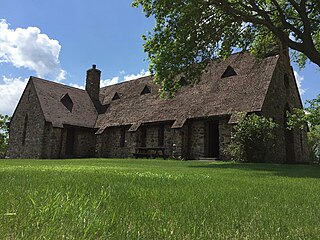
St. Catherine's Church of Lomice, North Dakota, near Whitman, North Dakota, United States, was built in 1936. It was designed by architect Joseph Bell DeRemer in Late Gothic Revival style. It has also been known as St. Catherine's Catholic Church, as St. Catherine's Church, and as St. Catherine Church. It was listed on the National Register of Historic Places in 2006. The listing included one contributing building and four contributing objects on 5 acres (2.0 ha).
Duncan Church, also known as Saint Placidus Catholic Church, is a historic church near Gann Valley, South Dakota. It is located southwest of Crow Creek, about 2 miles (3.2 km) south of the county line. It is about 13 miles (21 km) north and west of Gann Valley. It was built in 1927 and was added to the National Register in 1999.

St. Martin's Catholic Church and Grotto is a historic church complex located at 612 Main St in Oelrichs, South Dakota. It features Late 19th and Early 20th Century American Movement architecture and was added to the National Register of Historic Places in 2005.
The Winona and St. Peter Railroad was a railroad in the Midwestern United States. It was founded in 1861 in Winona, Minnesota. The first 11 miles (18 km) from Winona to Stockton, Minnesota, were completed by the end of 1862, making the it the second operational railroad in Minnesota, after the St. Paul and Pacific Line from Saint Paul to St. Anthony Falls.
The Ashley Jewish Homesteaders Cemetery is an early 20th century burial site near Ashley, North Dakota. The Russian and Romanian Jews who farmed the area beginning in 1905 arrived as refugees fleeing pogroms and persecution. They had never farmed before, due to restrictions against Jews owning land in their native countries. Despite this lack of experience and the many rocks and boulders that peppered their claims, with the assistance of their German-Russian neighbors, and hard work and persistence, the great majority of them were successful enough to buy their land outright prior to the five-year waiting period contained within the Homestead Act of 1862, or to own their land at the five year mark.
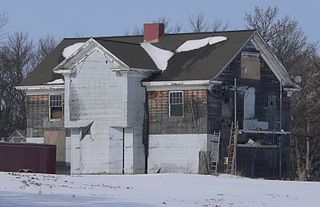
Aggergaard Manor is a historic house in Irene, South Dakota. It was designed in the Colonial Revival style, and built in 1904 for Peter N. Aggergaard, an immigrant from Denmark. Born in 1844, he emigrated to the United States in 1872 and became a homesteader in the Dakota Territory in 1873, eventually owning 16,000 acres. Aggergaard sponsored Danes to emigrate to the United States and work on his farm. He was also a banker, and he became known as the "King of the Viborg settlement." He lived here with his wife, their three sons and six daughters; he died in 1921. The house has been listed on the National Register of Historic Places since June 6, 2001.


















